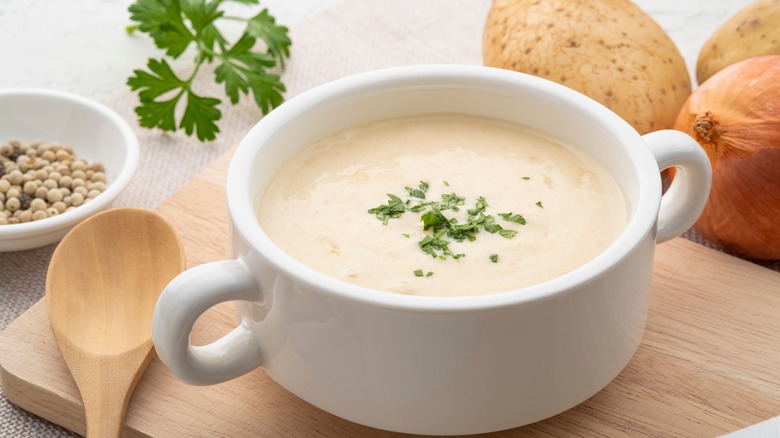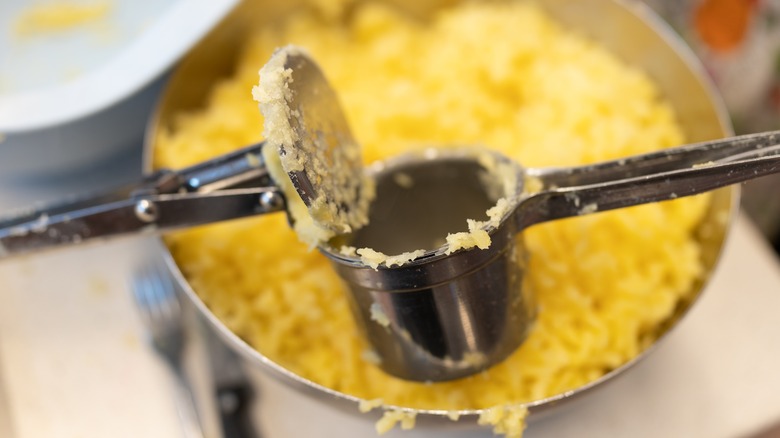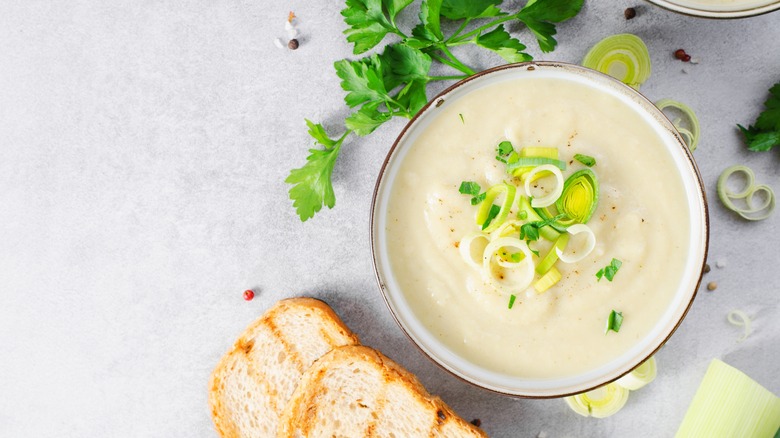Stodgy Potato Soup? It's Time To Break Out The Ricer
Whether it's warm and creamy and loaded with baked potato fixings, or served chilled with a few snips of fresh chives, a well-made, pureéd potato soup can be a little ethereal. Potato soup has few ingredients, and making it only takes a couple of steps. Technique is everything, however. If you aren't careful with the delicate starches in the potatoes, you can end up with a goopy, gluey, stodgy soup. If you want your potato soup to have a perfect light, fluffy texture, don't automatically reach for a blender or a food processor when it's time to pureé the potatoes. Instead, run your cooked potatoes through a ricer before adding them to the rest of the soup ingredients.
A potato ricer is a handheld tool that looks like a big garlic press and works the same: A plunger forces boiled potatoes through small holes. It's a gentle way to process the potatoes and produces perfectly puffy mashed potatoes with just a quick squeeze. Those fluffy spuds are exactly what you're looking for to make smooth, silky potato soup.
Potato starches are delicate, handle with care
When potatoes are cooked, especially when they're boiled in water or steamed, their starch molecules fill with moisture and separate, which makes the flesh of the vegetable soft enough to eat. Those starch molecules are delicate, so if you mash your cooked potatoes too much, the cell walls of the starch molecules will break apart, ruining the structure and texture of your spuds. It takes a lot of elbow grease to over-mix potatoes by hand; when you use a machine, however, it's very easy to accidentally go too far. And when it comes to pureéing soup, using a blender or a food processor is where most potato soups go wrong.
If you've ever made a potato soup at home and it just didn't come out the same as soups you had at a nice restaurant, there's a pretty good chance that the difference comes down to how the potatoes were processed. Chefs love using potato ricers for two reasons: First, they make mashed potatoes in just one move, so they're quick. Second, the starch molecules remain mostly intact because the potatoes were only minimally processed.
Make mashed potatoes first, then make potato soup
It's important to keep those starch molecules in mind when you make your next batch of potato soup. Instead of blending everything all at once, use a two-step process. First, boil or bake your potatoes then run them, unpeeled, through the ricer to make smooth and fluffy mashed potatoes. Secondly, season the riced potatoes to taste then add your soup liquid. Note: If you cook your potatoes in the soup liquid, pour the pot of cooked potatoes into a colander over another pot to collect the potatoes and the hot broth in two separate containers.
Once you've got all your ingredients combined, gently stir everything together with a big spoon until it's at soup consistency and it's ready to serve. Although making perfect potato soup does take an extra step and an extra tool to get the texture just right, it's worth the work to get restaurant-quality results.


